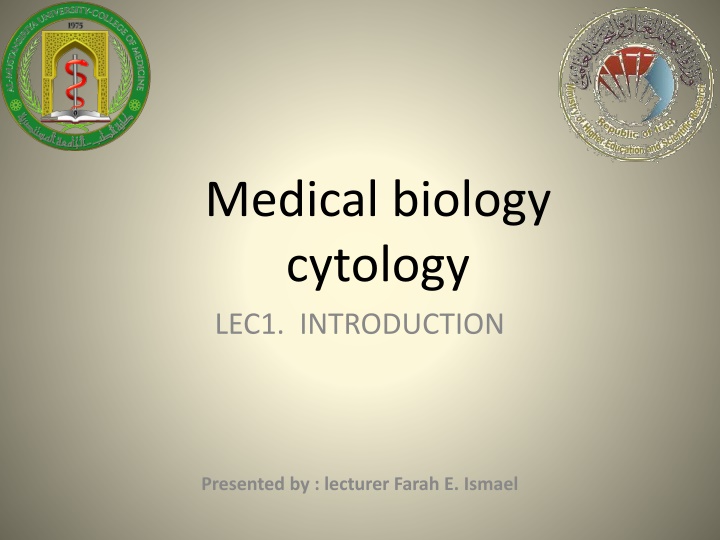
Introduction to Medical Biology and Cytology
Explore the fundamentals of medical biology and cytology, including the levels of human organization, cell types, and internal cell structures. Learn about living organisms, cell functions, and the classification of cells into prokaryotes and eukaryotes. Delve into the science of cytology and the significance of cells in maintaining homeostasis.
Download Presentation

Please find below an Image/Link to download the presentation.
The content on the website is provided AS IS for your information and personal use only. It may not be sold, licensed, or shared on other websites without obtaining consent from the author. If you encounter any issues during the download, it is possible that the publisher has removed the file from their server.
You are allowed to download the files provided on this website for personal or commercial use, subject to the condition that they are used lawfully. All files are the property of their respective owners.
The content on the website is provided AS IS for your information and personal use only. It may not be sold, licensed, or shared on other websites without obtaining consent from the author.
E N D
Presentation Transcript
Medical biology cytology LEC1. INTRODUCTION Presented by : lecturer Farah E. Ismael
Objectives of this lecture Introduction into the medical biology. Understanding the levels of human organization.(mentioned in previous lecture) Understanding what is the cell and its main types Introduction on internal structure of human cells . 2 lecturer Farah E.Ismaeel Thursday, March 20, 2025
Introduction Medical biology is a field of human biology that has practical applications in medicine, health care and laboratory diagnostics. Human Biology is the study of human beings and populations from a biological point of view. Biology is the science that studies all living things and their environments. 3 lecturer Farah E.Ismaeel Thursday, March 20, 2025
Introduction All living things called living organisms. organism mean living system All organisms are capable of 1) Response to stimuli. 2) Reproduction, growth and development 3) Maintenance of homeostasis as a stable whole 4) Acquire materials and energy from the environment 5) Have an evolutionary history and are adapted to a way of life. 6) They have levels of organization 4 lecturer Farah E.Ismaeel Thursday, March 20, 2025
levels of organization 5 lecturer Farah E.Ismaeel Thursday, March 20, 2025
6 lecturer Farah E.Ismaeel Thursday, March 20, 2025
What is the cell Cell Cell is a smallest basic structural and functional unit of all living organisms that maintain proper homeostasis of the body. The science that studies the microscopic appearance of cells known as cytology cytology 7 lecturer Farah E.Ismaeel Thursday, March 20, 2025
Biologists classify cells into two broad categories the prokaryotes and eukaryotes. 8 lecturer Farah E.Ismaeel Thursday, March 20, 2025
Cells are classified according to present or absent of nucleus to Prokaryotic cells are cells that do not have a true nucleus or membrane-bound organelles. Characterized as : unicellular " is an organism that consists of a single cell" Small size (1-5 m). Have cell wall outside the cell membrane. Lack a nuclear envelope separating the genetic material (DNA) from other cellular constituents. Have no histon (specific basic proteins) bound to their DNA. Have no organelles except ribosome. Prokaryotic cells divide by binary fission. 9 lecturer Farah E.Ismaeel Thursday, March 20, 2025
Eukaryotic cells are cells that contain a nucleus and organelles, and are enclosed by a plasma membrane. Organisms that have eukaryotic cells include protozoa, fungi, plants and animals. Characterized by: Larger than prokaryotic cells. Have distinct nucleus surrounded by nuclear envelope. Histones are associated with the genetic material. Numerous membrane-limited organelles are found in the cytoplasm. Eukaryotic cells divided by mitosis & meiosis. 10 lecturer Farah E.Ismaeel Thursday, March 20, 2025
Internal Structure of human Cells Certain structural feature common to all human cells. In general the basic human cell components are: 1. Plasma membrane (plasmalemma or cell membrane). 2. Cytoplasm: that includes cytosol, cell organelles and inclusions. 3. Nucleus. but there are some different between cells according to cell type and cell function. 11 lecturer Farah E.Ismaeel Thursday, March 20, 2025
12 lecturer Farah E.Ismaeel Thursday, March 20, 2025
The human organism present about 200 different cell types. 13 lecturer Farah E.Ismaeel Thursday, March 20, 2025
14 lecturer Farah E.Ismaeel Thursday, March 20, 2025
15 lecturer Farah E.Ismaeel Thursday, March 20, 2025


















